- Enterprise chatbots automate tasks across departments, integrating with internal systems to streamline operations at scale.
- They differ from regular chatbots by requiring higher security, broader use case coverage, and deeper data integration.
- The most common use cases include customer support, lead generation, HR, and IT — all areas with repetitive, high-volume tasks.
- One bank saved €530,000 by deploying a chatbot, showing how enterprise AI delivers measurable cost savings.
AI chatbots are everywhere – and most of them are deployed by businesses.
Our company has helped deploy tens of thousands of chatbots (yes, really). Most of them belonged to businesses, and they’ve spanned every industry you can name.
In this guide, I’ll walk you through:
- How to figure out what type of business chatbot is right for your company
- A step-by-step on how to implement a chatbot for business
- And provide a list of tools to get you started
What are enterprise chatbots?
An enterprise chatbot is a conversational AI software that automates and streamlines tasks across different departments at a company. They’re commonly used for customer service, HR, and IT support.
Unlike a simple chatbot, enterprise chatbots are more versatile and scalable, capable of handling complex tasks: integrating with CRMs and ERPs, automating workflows, providing personalized customer experiences, and assisting with internal processes.
They can be deployed across multiple departments, from HR and IT support to sales and marketing.
What's the difference between enterprise chatbots and regular chatbots?
Because enterprise chatbots are often deployed at a larger scale than typical chatbots, there are a few differences:
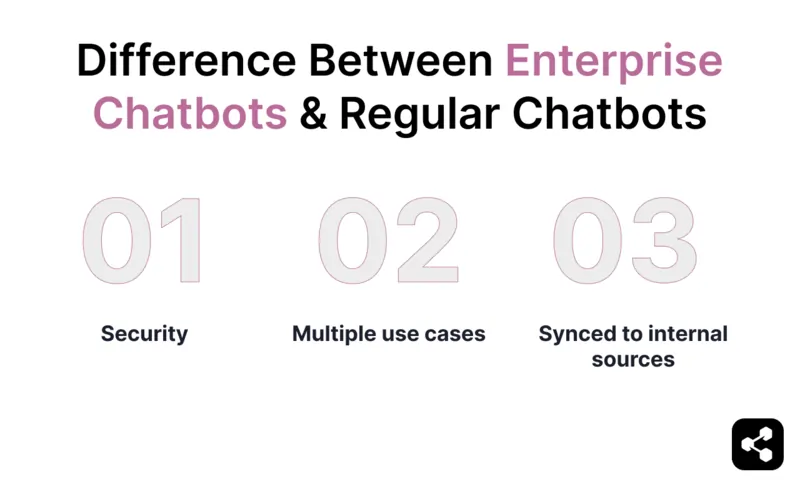
1) Security
Enterprise chatbots often have more stringent security requirements. And chatbot security is serious. When they’re integrated into daily-use systems, or they participate in high stakes processes, an enterprise chatbot needs high-level security standards.
This typically means picking a chatbot platform that abides by compliance frameworks like SOC 2, HIPAA, or the GDPR.
If an enterprise chatbot will be handling customer data – like payment details, full names, or addresses – it must be built fully in-house or on a secure platform.
2) Multiple use cases
The most effective enterprise chatbots are deployed across use cases, not limited to one purpose.
If a customer support chatbot is a success, why not use the same AI technology to qualify leads or train new employees?
While many chatbot platforms specialize in singular use cases, we’ve found that our enterprise clients are far more satisfied when they make the most of their enterprise chatbot platform by extending the scope of their AI deployment.
3) Synced to internal sources
Enterprise chatbots need to be synced up with a company’s internal data (like product stock or HR policies), as well as the most useful systems (like a CRM) in order to maximize their efficiency.
If a chatbot isn’t properly integrated with existing systems, it becomes an extra step for customers or employees, rather than an automation of existing workflows.
Enterprise chatbots almost always use retrieval-augmented generation (RAG) to ensure that their output is grounded in a company's information. Using RAG reduces the risk of hallucinations (i.e. a chatbot sharing inaccurate or misleading information).
Enterprise vs Midmarket vs Small Business Chatbots
There’s huge variation between businesses, which means there’s huge variation between business chatbots. A multi-billion dollar enterprise is going to opt for a different type of bot than a mom-and-pop shop.
Enterprise, midmarket, and small business chatbots can often be built with the same tools (i.e. a flexible chatbot platform), but they’ll include some key differences.
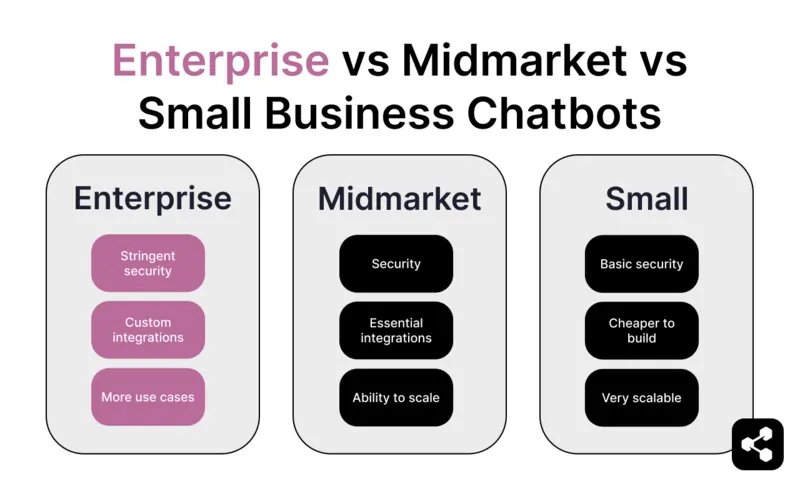
Enterprise Chatbots
Enterprise chatbots are designed for large organizations that require deep integrations, scalability, and governance across complex business systems.
What distinguishes an enterprise chatbot?
- Enterprises tend to exist in many legal jurisdictions and handle more personal data, so their bots tends to have more stringent chatbot security requirements
- Enterprises often use bespoke internal platforms (for communication, analytics, etc.), which requires custom integrations to connect with a bot
- A company with more departments will have more use cases for a chatbot
These key differences mean that an enterprise chatbot needs serious security and high flexibility (i.e. to build custom integrations and scale). They'll need to abide by GDPR, SOC 2, and any other relevant data protection frameworks.
Midmarket Chatbots
Midmarket chatbots are flexible chatbots that automate customer interactions and workflows while integrating with essential business tools without enterprise-level complexity.
A step away from enterprise chatbots, midmarket chatbots don't always need custom integrations (since many chatbot platforms come with pre-built integrations to major platforms).
Security is still integral to midmarket chatbots, and the ability to scale a chatbot as the business grows is especially important.
Small Business Chatbots
Small business chatbots are often chatbots that adapt to growing business needs without requiring extensive technical resources.
Small businesses often use chatbots to scale their operations beyond what their small team can accomplish alone. Common use cases tend to include AI lead generation and customer service, since these tasks traditionally take a lot of human labor to scale.
Because of their smaller scale, chatbots used by small businesses will always be cheaper than midmarket or enterprise chatbots.
Common Use Cases for Enterprise Chatbots
Use cases for enterprises are endless – as long as your platform is extendable, you can configure an AI chatbot to do anything.
But there are a few common use cases of enterprise chatbots:
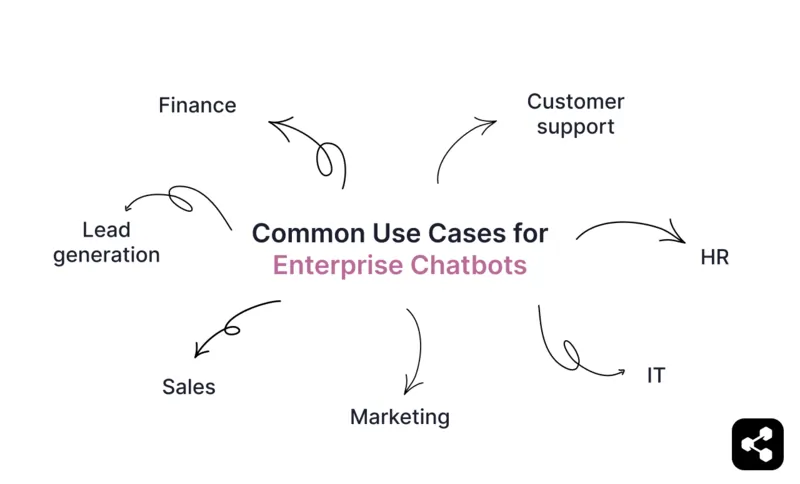
Customer Support
You’re probably (and unfortunately) unfamiliar with the terrible customer service bots of years past. You can breathe a sigh of relief, because those brittle bots are a solution of the past.
Now, the best teams use AI for CX, instead of outdated bots.
These days, customer support chatbots are powered by LLMs. So instead of repeating the same circular flow when it gets stuck on a request, an LLM chatbot will understand nearly any request (typos and all).
These types of chatbots don’t just hand off issues — they solve them. They can pull answers from a knowledge base, guide users through troubleshooting, and only escalate when necessary.
Customer support bots are often used as an AI ticketing tool, triaging incoming requests and autonomously deciding how to prioritize them. At scale, they can source entire AI contact centers for enterprise customer support needs.
Lead Generation
Most lead generation tasks will be AI lead generation in the next few years – 40% of businesses back in 2023 planned to increase their AI investment in lead gen.
Most chatbots you interact with are lead generation bots, even if you might not know it.
A lead gen bot might offer price estimates after collecting information about your project requirements. Or it might act as a consulting service, suggesting tailored solutions while qualifying the lead at the same time.
Lead gen is the most popular use case in an AI-enhanced sales funnel, given the large number of leads that need to be created for a healthy pipeline. Luckily, these bots can qualify leads too – so no funnel will fill up with unqualified candidates.
Sales
There are endless ways to use AI for sales – the only limit is your creativity.
A chatbot in sales can handle tasks like qualifying leads, answering product questions, and scheduling demos without needing a human rep to step in right away.
Sales chatbots can provide instant responses to common sales inquiries, like pricing, product comparisons, or feature breakdowns.
If a lead isn’t ready to buy, the chatbot can follow up later with additional details or book a meeting with a salesperson.
With the rise of online shopping, sales bots are especially popular in the e-commerce industry. E-commerce chatbots or retail chatbots are often little digital assistants for customers browsing online – they can recommend products or even offer personalized discounts.
Marketing
Chatbots are a favorite amongst marketing teams, since many of their tasks can be scaled at will for better business results.
Marketing chatbots are diverse in task and ability. They can:
- Recommend products
- Host contests or giveaways
- Manage social media
- Act as digital BDRs
- Conduct personalized email campaigns
On the customer side, conversational marketing is a customer engagement strategy that uses real-time, personalized conversations to move prospects through the buying journey.
By chatting back and forth – similar to a lead gen use case – a marketing chatbot can qualify potential customers, answer product-related questions, and guide them toward relevant content or offers.
Finance
Errors in financial tasks can be deadly. Chatbots can prevent human error.
Chatbots for finance can streamline expense tracking, simplify tax calculations, send payment reminders, help predict financial forecasting, and keep the company up-to-date on regulatory updates.
The possible use cases get more specific across the wide domain of finance:
- Insurance chatbots can assist with claims processing, like the Waiver Group’s Waiverlyn
- Accounting bots can process invoices and categorization expenses
- And at big institutions, banking chatbots can pre-screen loans and detect patterns of fraud
Human Resources
Plenty of HR reps are sick of getting the same questions over and over again. From enterprises with HR departments to start-ups with no HR manager, HR chatbots can step in and level up the employee experience.
HR chatbots can be simple: They answer FAQs about policies and they take vacation requests.
HR chatbots can also be complex: They can learn how often enterprise employees call in sick and then create a predictive schedule to avoid last-minute scrambling.
Its range just depends on a company’s needs.
For example, one of our partner organizations deployed a chatbot that was put in charge of vacations and scheduling. The AI chatbot learned to predict when employees would call in sick or request the most days off, and was able to plan accordingly in advance.
Note: Our business uses a lot of chatbots, but the most beloved is our HR bot named Harry Botter. It answers questions about benefits, insurance, time off, the employee directory, or other HR-related queries.
IT and Tech Support
IT chatbots are another common use case for businesses. Plenty of troubleshooting follows the same steps, so it makes sense to offload the most common issues to a bot.
(One of our clients was able to reduce the number of calls going to their call center by 30%.)
For employees, IT support chatbots can reset passwords, onboard users to new software, or troubleshoot.
But they can also help with overall IT strategy – they can simplify the distribution and management of IT resources and ensure proper safety and compliance.
Examples of Enterprise Chatbots
A finance bot that saved €530,000
VR Bank Südpfalz, a historic financial institution, leveraged AI chatbots to streamline loan applications and retirement planning, achieving €530,000 in cost savings and a 56% containment rate.
Handling over 3,000 real estate loan applications annually, the bank faced high processing costs and regulatory complexity. To address this, they introduced AVA, a chatbot that gathers applicant details, integrates with their CRM, and provides real-time assistance 24/7.
Following its success, VR Bank expanded AVA’s capabilities to retirement planning, allowing customers to track their investments and optimize savings. This automation saved an average of €53 per conversation, significantly cutting costs while enhancing customer experience.
A customer support bot with 0 hallucinations
RubyLabs, the company behind Able, a personalized health coaching platform, drastically reduced customer support ticket volumes by automating responses and subscription management.
In the health sector, accuracy matters. A key success factor for RubyLabs was 0 AI hallucinations across 100,000 conversations, ensuring precise information in high-stakes health and payment-related interactions.
After introducing an AI-powered support system, RubyLabs saw a 65% reduction in manual tickets and saved $50,000 annually – all while maintaining accurate and reliable responses.
With automation handling routine inquiries, the company improved response times, eliminated the need for Tier 1 support, and streamlined operations across its entire product line.
A lead gen and booking chatbot that increased leads by 25%
Waiver Group needed a way to book more consultations without adding more work, so they launched Waiverlyn, an AI chatbot to answer questions, qualify leads, and automatically schedule meetings.
Instead of waiting for someone to reply to a contact form, potential clients could chat with Waiverlyn, get the info they needed, and book a consultation on the spot.
The bot even fills out calendar invites, updates sales spreadsheets, and sends follow-up emails, making sure nothing slips through the cracks.
The impact was immediate: consultations shot up 25%, visitor engagement jumped 9x, and the chatbot paid for itself in just three weeks. It also helped filter out low-quality leads, so the sales team could focus on serious prospects instead of chasing down dead ends.
Now, Waiver Group is looking at how to make it even more powerful, turning a simple chatbot into a full-blown sales assistant.
5 Benefits of an Enterprise Chatbot
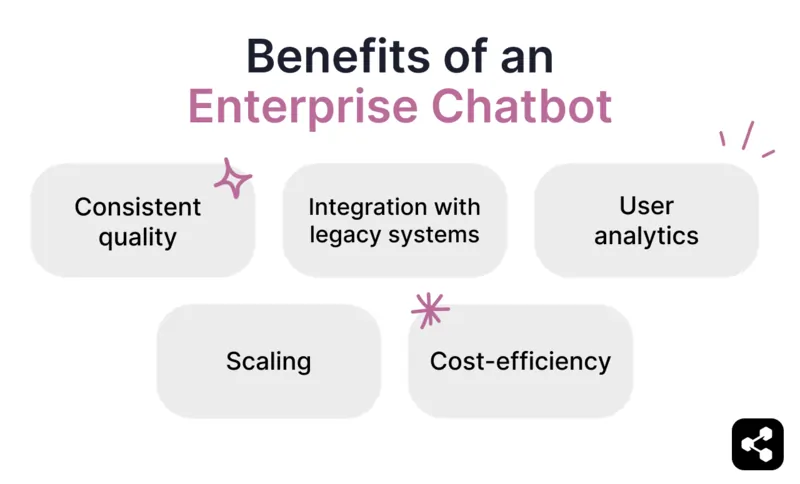
Enterprise chatbots are on the rise, and for good reason. The structure and needs of companies – particularly companies that span across countries – are ideal for chatbot solutions.
We’ve deployed chatbots and AI agents to enterprises for years. Here are 5 key benefits that we’ve seen enterprises value the most:
1) Scaling
When you’re managing operations across countries, it can be time-consuming and difficult to build and scale new processes.
That’s why one of the main reasons enterprises use chatbots is to scale their operations.
A key part of scaling is identifying technology that can automate repetitive tasks and ensure a consistent experience for users (whether they’re customers, employees, or leads).
Ideally, your customer journey remains consistent, no matter how many customer interactions your company sees each day. Chatbots are an ideal way to ensure standard practice as processes scale up.
2) Consistent quality
One of the overlooked benefits of using chatbots for enterprises is their ability to deliver reliable, high-quality services.
Unlike human agents, conversational AI software never has a bad day. Enterprise chatbots can handle any type of customer inquiries without a reduction in morale – advanced natural processing understanding allows a chatbot to detect certain emotions, but it will only improve the quality of service.
Deploying a strong enterprise chatbot will improve customer satisfaction, as long as you keep human agents in the loop for high-level calls.
There will always be customers who need a human touch or face a brand-new problem – your customer service teams will be able to spend more of their time on high-level customer satisfaction.
3) Integration with legacy systems
Most enterprises are built on solid foundations – it can feel near-impossible to change technology infrastructure.
AI chatbots don’t disrupt enterprise tech stacks. They can be integrated with existing systems in order to enhance workflows, rather than make employees transition from one system to another.
Internal processes can remain on the same touchpoints, just streamlined or, in some cases, fully automated.
If integration with legacy systems is a key need for your chatbot, then ensure you select an enterprise chatbot platform with open standards.
4) Cost-efficiency
Automation means savings. When your employees are freed up to work on higher-level tasks, your company’s ROI soars.
Any conversational AI software can handle basic customer issues, and well-built chatbots can even process complex queries.
Your sales teams and customer service teams can reduce their overall spend while increasing levels of customer engagement with an AI chatbot. Enterprise systems rely on cost-efficiency, and chatbots are a proven way to meet demand without breaking the bank.
5) User analytics
Plenty of tools collect valuable data from your customers – an enterprise chatbot not only collects valuable data, but provides comprehensive customer insights.
The best enterprise chatbot platforms will analyze customer insights, like which products have the user inquiries, what services result in the most support requests, levels of customer satisfaction, or direct customer feedback.
The direct customer information gleaned by enterprise chatbots – combined with their integration to your company’s other performance metrics and enterprise data – means they offer a streamlined, accurate view of what your customers like, want, and expect.
While it’s not often their direct purpose, an enterprise chatbot provides valuable insights about your customers. If improving customer engagement with data is on your radar, gaining customer insights from a chatbot is a direct method of data collection.
How to Ensure Secure Enterprise Chatbot Deployment
Holdouts to the AI wave often point to security as the reason for their hesitation.
Since artificial intelligence has only seen widespread commercial use in recent years, there have been plenty of mismanaged deployments.
Decision-makers should be especially cautious when deploying enterprise chatbots that will process personal data, like last names, passwords, or credit card information.
Enterprise chatbot platforms will provide security standards that safeguard how your chatbot uses sensitive information, as well as the type of information it can dispense. (You can read more about the Botpress security suite here.)
When a chatbot is synced with internal data, it’s able to provide accurate responses to the tee. And when security systems are built into your platform, your chatbot is unable to use information beyond the scope of your usage.
How to Implement an Enterprise Chatbot
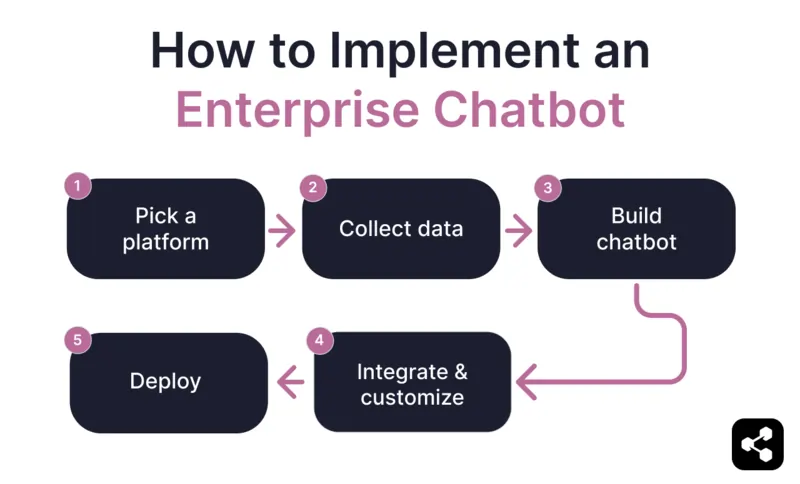
Step 1: Pick a platform
We’ve seen plenty of enterprises that decided to build their own chatbot from scratch. It can be an appealing choice: full reigns, ensured security, no monthly subscription fee. But few undertake this path for long.
Building from scratch is time- and labor-intensive – and it ensures your chatbot will either take far longer or be of a much lower quality.
As you pick a platform, keep in mind your company’s unique needs. If you want a platform that doesn’t limit the possibilities of your chatbot, look for an enterprise chatbot platform that has open standards and an extensible stack.
If data privacy is your biggest concern, look for a platform that boasts high security standards. If you have a beginner developer team, look for a platform with a user-friendly interface.
If you need some inspiration, you can browse our list of the 9 best chatbot platforms. And if you’re interested in taking a call tomorrow, you can reach out to our sales team.
Step 2: Collect your data
If you’re looking to train your chatbot on company information – like HR policies, or customer support transcripts – you’ll need to collect the information you want your chatbot to train on.
Not every enterprise uses original data to train a chatbot. Often, advanced prompting is sufficient to design your chatbot’s flows.
But if you want a chatbot that takes an extra step to customize your company’s offering, then collecting data and using it to train your chatbot is one way to do so.
Step 3: Build your chatbot
When you pick your chatbot platform, make sure you choose one that comes with enough educational materials to assist your team throughout the build process.
For example, we offer academy courses, daily livestreams, and an extensive collection of YouTube tutorials. Bot building can be a difficult task when you’re facing the learning curve – having resources at your fingertips makes the process go far smoother than without.
And if your team is new to bot building, most enterprise chatbot platforms have a drag-and-drop visual flow builder that allows for easy visualization of your workflows.
Step 4: Integrate and customize
Chatbots don’t exist in a vacuum. Their purpose isn’t just customer interactions or explaining one set of policies.
The most useful chatbots for enterprise are integrated across your company’s systems and platforms.
This might mean tables and documents, your website, or other third-party services – think platforms like Hubspot, AWS, Google Analytics, Intercom, Calendly, Microsoft Teams, Slack, Stripe, Mixpanel, Telegram, WhatsApp, or Zendesk.
If you use an enterprise chatbot platform, most of your team’s building time will be spent on perfecting your bot’s integrations, rather than building the chatbot itself.
And if you pick a strong platform, it will allow you to customize your chatbot in tone and personality. You won’t need to select specific words, but you can direct when your chatbot should speak apologetically, or what type of language it should use to describe your products.
Step 5: Deploy
One of the best aspects of a chatbot is that it can easily be deployed across any platform or messaging channel.
Many enterprises choose to deploy a chatbot not just on their website, but on their social media channels or internal messaging platforms.
Enterprise chatbots are a streamlined way to action a successful omnichannel strategy. Your users can experience the same service across multiple channels, and receive platform-specific help.
For example, a customer communication coming from WhatsApp can ask to change their password on your internal system. A chatbot facilitates a seamless integration between your users and systems.
Deploy an enterprise chatbot next month
AI chatbots are quickly reaching mass adoption rates amongst enterprises – in customer service, internal operations, and e-commerce. The companies that are slow to adopt will feel the consequences of missing the AI wave.
Botpress is an endlessly extensible bot-building platform built for enterprises. Our stack allows developers to build chatbots and AI agents with any capabilities you could need.
Our enhanced security suite ensures that customer data is always protected, and fully controlled by your development team.
Start building today. It's free.
Or contact our sales team to learn more.
FAQ
How do enterprise chatbots work?
Enterprise chatbots use artificial intelligence and machine learning to automate processes across business use cases, like customer service, HR, and sales.
How can my business get AI-powered customer support?
AI-powered customer support is the use of artificial intelligence to enhance different aspects of customer experience, like answering user queries or processing purchases.
Will chatbots replace my job?
Enterprise chatbots aren’t designed to replace live agents; they’re designed to automate repetitive tasks and enhance employees’ existing workflows.
What’s an AI-powered enterprise?
An AI-powered enterprise is a company that uses artificial intelligence technologies to enhance multiple business processes across departments, both internally and externally.





.png)

